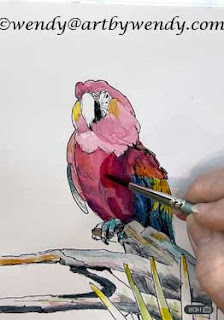Mixing Watercolours on Paper is a GAME CHANGER!!
I know, mixing all those puddles of colour can be a very meditative practice. One that helps to set up the process and nourishes inspiration. I love to do it too.
But . . . mixing puddles is not the only way to find that special colour.
 |
| Scarlett Macaw: A Play of Colour - Matted 14 x 18, $340 |
In my last blog, May 4, 2025, "6 Steps to Mixing Watercolour on Paper" I discussed how I used this technique to paint my Macaw. When I finished, I was asked how would paint the background.
I realized this too was a very useful place to use this technique, BUT with one very important difference.
Things are much WETTER.
************
There is further discussion on this topic on my YouTube post: The Magic of Mixing Watercolour on Paper Part 2
************
There is further discussion on this topic on my YouTube post: The Magic of Mixing Watercolour on Paper Part 2
************
Mixing Colour on the Paper Part 2:
I love using this method as it gives me a background that moves from loose to tight and gives great depth to my work. It also helps to bring cohesion to my piece.
 |
| Wet the area in the background |
1. Wet down the area to be covered: At this point you can also mix some of those paint puddles. It is good to have a puddle of each of the major colours used in your subject area. (You will notice I am not finished in the mid and foreground but I wanted a better idea of what my background values were before I finished off the front.)
 |
| Drop in colours |
2. Drop in Colour: I use all the colours that are found in my mid and foreground when I drop in my colours. It is important to drop colours beside other colours so they only mix at the edges. This is not a time to fiddle, just drop and move on.
 |
| Begin to suggest shapes |
3. Begin to create shapes: Yes, the paper is still wet, not soaked, but damp. I start to add some shapes. At first, the colour I was adding on top was running which told me I was too soon. I want to start adding shapes but I don't want their edges to be too fuzzy. This is a test-as-you-go situation.
 |
| Create more shapes |
4. Create more shapes: Referring to my reference I add shapes that would be in the background. Notice how my paint on top of the underpainting gives me lots of variety in the background colours but still stay true to my mid & foreground.
 |
| Adding Bolder Shapes |
5. Add Bolder Shapes: The final shapes are getting bolder and their edges are getting sharper. I am still working on damp paper but as you can see shapes are keeping their form. You may have to spritz your paper a bit to keep it damp.
This whole process goes quite quickly. There is no time for mixing extra paint or wondering off. As I worked through the background I did paint the rock in the front. This was because things were too wet and I needed to patiently monitor how wet/damp things were.
It is very important that your brush strokes are smooth and confident. This is not a place to rework an area or fiddle around. If you do that you will loosen the pigment underneath and things will lose their fresh clean look.
Special Note: This is no place for a blow dryer. Work while things are damp and then leave it to dry naturally. This will help to give you some interesting mixes on your paper.
You may want to practice this a few times before hitting your main piece. Once you have mastered this technique, you will find this method is very helpful no matter what part of your painting you are working on.
Have fun with your painting.
************
There is further discussion on this topic on my YouTube post: The Magic of Mixing Watercolour on Paper Part 2
************
There is further discussion on this topic on my YouTube post: The Magic of Mixing Watercolour on Paper Part 2
************
Taking Registrations for my Spring/Summer Events:
- 4 Day Outdoor Sketching Art Retreat hosted by Joanne Denis, June 20-23, 2025. I will be the instructor. This is an all inclusive: food, instruction, accommodations and drive from Lower Mainland. $350-$600 depending on the room choices. www.aventurasbc.ca
- Create Your Own Adventure - Let's go Outdoor Sketching 2.5 hr $85. Sm Group Rates $65ea Contact me to set up a date. Location: Lower Mainland
- Save the Date: next set of 3 Zoom classes Thursdays, October 9, 16 & 23. Enhancing Your Drawing & Painting Skills. New focus for each set of classes
Original work, Commissions, Private Drawing Lessons, Prints and Cards of her Work,
Be sure to like and share my posts. You won't miss a single post if you Follow by Email
Have a great Artful Day,
Wendy







